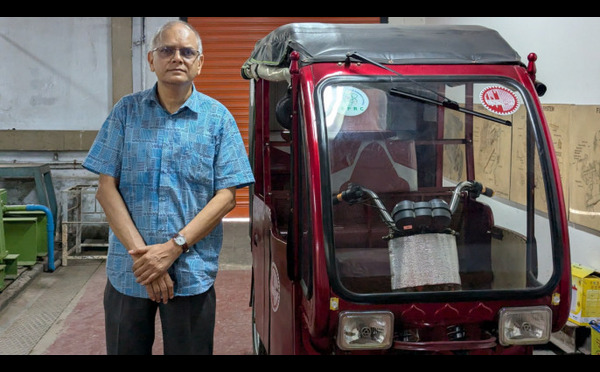Buet’s smart fix for Dhaka's autorickshaws
Buet’s smart fix for Dhaka's autorickshaws

One hand strongly gripping the side, one foot braced forward, and a subtle lean when the road buckled beneath. That’s how Professor Md Ehsan learned to ride a rickshaw as a child.
Years later, when his own children climbed onto Dhaka’s rickshaws, he passed down the same tips: hold tight, anticipate the tilt, mind your balance.
But why must one learn to ride a simple vehicle like a rickshaw?
That question sparked a quiet revolution inside the mechanical engineering department at Bangladesh University of Engineering and Technology (Buet). Under Prof Ehsan’s leadership, a small team of six set out to build something no one else in Bangladesh had tried before.
The result was a reimagined, safer battery-run autorickshaw, made entirely in Bangladesh.
Familiar problem, reinvented
Dhaka streets are home to two main types of rickshaws – manual pedal versions and their electric offspring. Most battery-run autorickshaws (often called “easy bikes”) aren’t purpose-built.
They’re retrofitted pedal rickshaws with fragile frames modified with motors and batteries.
The result? More speed, far less safety.
“Everyone’s building their own version,” said Prof Ehsan. “No regulation, no common standard. We’ve been warning about this for years.”
In 2020, the government finally took notice. The Bangladesh Energy and Power Research Council asked Buet to design a viable alternative. Ehsan’s team got a research grant in 2021 and launched a nationwide investigation.
They didn’t start in the lab. They went to the streets.
For six months, the team travelled across the country. They rode autorickshaws, visited roadside garages, and spoke to drivers and mechanics.
“We found at least ten or eleven different versions,” said Ehsan. “Many had no proper brakes. Some didn’t even have roofs. In winter, drivers stitch plastic or cloth around the sides just to stay warm.”
Even more alarming was the business model. Most rickshaws were owned by private investors, not the drivers. And the manufacturers? They cut corners to save costs – ignoring basic safety features.
“They didn’t care about braking, or weight distribution,” Ehsan said. “They just wanted to sell more units.”
Science steps in
The Buet team decided to fix the issue at the root. Their goal was a standardised autorickshaw that prioritises safety, ensures affordability, and fits local manufacturing capabilities.
The result was a prototype that looks familiar but behaves very differently.
At 3.2 metres long and 1.5 metres wide, the new rickshaw maintains a compact footprint. But it’s limited to two passengers – a key design choice to ensure balance and prevent tipping.
The improvements run deep: hydraulic disc brakes on all wheels, a proper parking brake, mirrors, indicators, a curved windshield, and a sturdy canopy. The battery is housed securely, and the structure reinforced for weight distribution.
Most importantly, its top speed is capped at 30km/h – safe for its build.
“You can’t just add a motor to a pedal rickshaw and expect it to behave,” said Ehsan. “Speed must match the structure. Otherwise, you’re building a deathtrap.”
The new design can be produced for around Tk1.5 lakh – comparable to existing unsafe models.
Stigma and setbacks
Still, not everyone was convinced.
“When we started, people would laugh,” said Ehsan. “They’d say, ‘A Buet professor building rickshaws? Why not planes?’ But we weren’t ashamed. These rickshaws carry our mothers, our children. Why shouldn’t we care?”
By 2022, the team had completed the prototype. Ministries praised it in early 2023, but political instability slowed progress.
That changed recently.
With a renewed push for urban safety, government interest has revived. Dhaka North has confirmed it will issue new licences specifically for Buet’s model.
“Right now, anyone can rent a battery rickshaw and start driving – no licence, no training,” said Mohammad Ejaz, DNCC administrator. “That’s about to change.”
Drivers will soon need NID-linked permits and must complete training before getting on the road. For now, the rollout is limited to Dhaka, but a nationwide expansion is on the table.
New roadmap
For Prof Ehsan, the mission is far from over.
“We’ve created a platform,” he said. “This design can evolve. We can add GPS, solar charging, even smart diagnostics. But first, we must get the basics right.”
And when might we see them on the streets?
“Soon,” he said. “We can’t fix everything overnight. But if we can make our roads even a little safer – one rickshaw at a time – that’s a start.”


